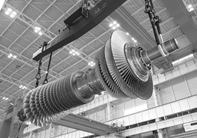Turbocharger Upgrades Yield High ROI -ABB
Power and automation technology group ABB announced study results show return on investment from turbocharger upgrades. The increased revenue resulting from higher engine output of three engines in a power plant accumulated to approximately $537,000 per year, and in addition, fuel savings of $470,000 per year were realized. Forrester Consulting conducted a study examining the return on investment (ROI) from upgrading ABB turbochargers for a major power plant operator in the Caribbean. Data gathered and analyzed from the three engines before and after the upgrade indicated a Net Present Value of $1.4 million three years, with an annual value of $824,000 and a payback time of 11 months.
MHI to Introduce M501JAC Gas Turbine

Mitsubishi Heavy Industries, Ltd. (MHI) has developed and is now marketing the "M501JAC" gas turbine, an air-cooled version of the company's state-of-the-art steam-cooled J-Series gas turbine introduced in 2009. The M501JAC features outstanding operability, including reduced start-up time, while maintaining the same level of performance as the M501J. By expanding its J-Series lineup of gas turbines offering the world's highest level of efficiency, the company is well positioned to take the lead in the high-end gas turbine market.
Wärtsilä Debuts World’s Most Powerful Engine
The first 14-cylinder Wärtsilä RT-flex96C marine engine has a maximum continuous power output of 80,080 kW (108,920 bhp) at 102 rpm. Measuring 27.3 m long and 13.5 m high, it has an overall weight of 2300 tons. The world's first 14-cylinder low-speed engine entered service on September 1 in a large, fast container vessel. Developed by Wärtsilä Corporation, the 14-cylinder Wärtsilä RT-flex96C engine is also the world's most powerful engine with an output of 80,080 kW (108,920 bhp) at 102 rpm. The 14-cylinder Wärtsilä RT-flex96C engine is a major breakthrough for ship propulsion. It extends the power available to suit the new generation of large containerships while combining the benefits of proven, reliable engine designs with the complete flexibility of RT-flex common-rail technology.





